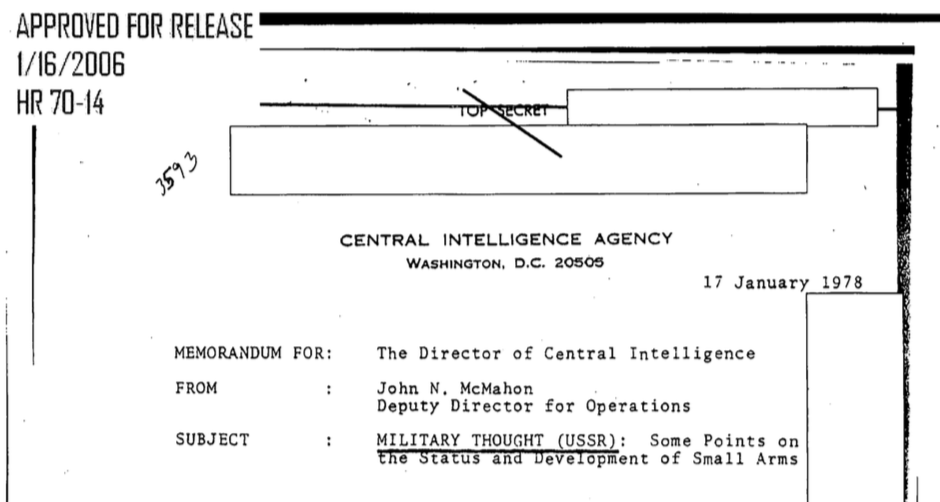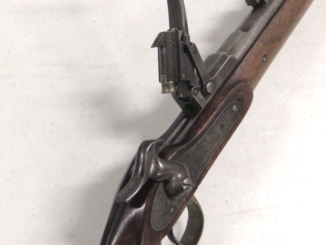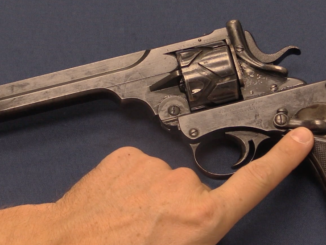The Dutch government adopted the Luger for the KNIL (Dutch East Indies colonial forces) in 1910, and placed an initial order for 4,182 pistols from DWM in Germany. These were standard 9mm New Model Lugers, with grip safeties, no stock lugs, and manual safeties marked “RUST”. When more pistols were needed by the KNIL after World Wa rOne, the Treaty of Versailles prohibited DWM from making them. Instead, the Vickers company tooled up to produce them at its Crayford factory. Back when Maxim-Nordenfelt licensed the Maxim gun to DWM, part of the deal was a reciprocal license for Maxim to produce DWM products. That was inherited by Vickers when they acquired Maxim-Nordenfelt, and it gave them the right to make the 6,000 guns ordered by the Dutch in 1923.
One of these has a “GS” marked barrel dated 1930, which indicated that it was rebarreled in the Dutch East Indies in 1930. It also has a 5-pointed star over the chamber, which is an Indonesian national property mark added in the 1950s. The other has a Dutch M11 pattern holster, complete with cleaning rod and loading tool.




Vickers also produced a version of the German M16 helmet, for the Irish army.
https://www.historyireland.com/20th-century-contemporary-history/artefacts-vickers-helmet/
http://cf.broadsheet.ie/wp-content/uploads/2014/09/helmets.jpg
Hello again, Ian!
I’ve been meaning to tell you for bacically years that you could use a snap cap to show a loaded chamber…keep up the great work, my friend.
Robert
Since Vickers Lugers are scarce and highly demanded, their wokmanship remain in “Utility Grade” as not in a quality in a par with German trade samples… IMHO…
Given the Relationship between DWM amd Vickers, the question is, did Vickers produce the 1923 KaNIL contract Ex-Novo, or simply assembled and fitted DWM parts ( semi finished) left over from WWI production ( as,with production in Germany of 1920 Commercials and Police Lugers.)
Is there any indication in Vickers Archives thatthis may have been the Case…
Commercially and economically, I don’t think
VICKERS would have engineered a complete Luger Production line Just for a few thousand Pistols, especiallyin the depressed 1920s Market…
It was very easyto avoid Versaillesby simply shipping some Parts and special machines as “Scrap” in keeping with Versailles rules ( and be seen to comply with German ” Disarmament”) rather than start a complete production line ( also the question of
Metric vs Imperial design and tolerances!).
It seems more logical to use DWM Metric Parts, so that the Pistols would match to earlier ( pre-war)
DWM conntracts.
BTW, “GS” does not stand for ” Gunsmithing School”, although the Original Dutch may ” Mean” this in translation…more likely
GEWEER Skule, ( Rifle School) ….my Dutch is very poor ( Martens and DeVries).
Otherwise, very good expose, although the Book on Dutch Lugets is obviously not on your ready reading list. ( Carter, I think?)…I don’t have my copy to hand.
Verynice Holster…how it survived WWII and the War of Independance ( 45-49) is amazing…knowing the tropical Indonesian conditions
Sincerely yours,
Doc AV
Down under
PS, Ian, give us a call on info@avbtechservices.com
Corona is getting a bitof a bore!!!
Not so sure. That may be the case, but as Ian mentions, they were desperate for business and a few years later tooled up to make the Pedersen.
The majority of Pedersens in private hands as opposed to museums in the US are probably Vickers ones.
There are also about a dozen to twenty or so I know of in the U.K., spread between the Royal Armouries (ex-Enfield collection) in Leeds, the Defence Academy at Shrivenham, the National Army Museum in London (one), the SASC at Warminster and the Navy Museum in Portsmouth (a few). They were all made from scratch by Vickers-Armstrong. Maybe the Lugers were too?
“(…)easyto avoid Versaillesby simply shipping some Parts and special machines as “Scrap” in keeping with Versailles rules ( and be seen to comply with German ” Disarmament”) (…)”
Finns did use another way to get around. They ordered Parabellum-pistole
http://www.jaegerplatoon.net/PISTOLS1.htm
in 7,65 x 21 and with 95 or 98 mm and as it was not 9 x 19 and below 100 mm it fit into was German were allowed to make after Great War. Order for longer replacement barrels went to Tikkakoski.
In a later Luger video, which brought me back to this one, Ian refers to only 4 sets of Luger tooling – and doesn’t mention Vickers in the list. Is this the mythical missing 5th set?
Is that a Dror or a Johnson LMG in the rack behind Ian? I’ve noticed it over the past few videos and was curious.
I’m pretty sure it’s a Johnson. Dror has an extended ventilated barrel jacket. And is really quite poor, whereas the Johnson is just average and over-hyped (by Melvin Johnson).
Anybody ever had their Johnson stuck in a Dror?
HA!
“(…)Dror or a Johnson LMG(…)”
I would say that magazine of said weapon is not one for Dror as curve do not fit – c.f. 1st photo from top http://zonwar.ru/pulemet/Dror.html
GS is the abbreviation for Geweermakers School (riflemaker’s school) according to de Vries/Martens, p. 257
Dear Mr. McCollum and the other Forgotten Weapons crew,
I noticed that on 05:45 (timestamp) Ian mentioned that the star marking was that of the early Indonesian military which was included after 1950 “when Indonesia got its independence”. Now, this quote sits uncomfortably with me as an Indonesian, since we’ve always been taught that Indonesian independence (or at least the declaration of independence) was in on August 17th 1945, two days after the surrender of Japan to the allies.
I wouldn’t completely say this is a mistake either, since from the perspective of the Dutch, they did not let go of the East Indies until December 1949. Despite this, your choice of words fogged up a lot of historical events around the the Indonesian independence, which is too complicated to write in a comment.
As a historian, I’d like you to at least reconsider the choice of those words. After all, wouldn’t it sit uncomfortably if I say that the American independence is in 1783, after the war has ended and the UK had accepted the US as a free country?
That’s fair enough. We don’t worry about what the Brits say about our independence, I don’t see why you should care what the Dutch say. (Psst – don’t tell em they really speak German!)
Did Vickers also provide parts e.g. replacement barrels, box magazines etc. and ‘support; for the Luger. Or was that ‘allowable’ for the Germans to supply – for the considerable number in service (+ the numbers in civil use)?
Vickers LTD manufactured most of the Luger parts, but some came from DWM.
I think that the lower number (“1” and “10”) on these guns refers to the location of the unit, not the weapon number, according to The Dutch Luger, Martins and de Vires (p 179). This started in 1939 and it’s not consistent. They kept changing the standard and often field units didn’t make the changes.